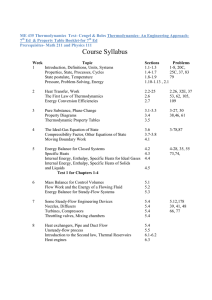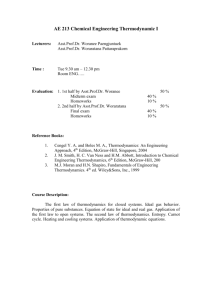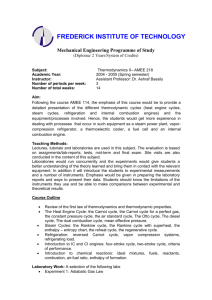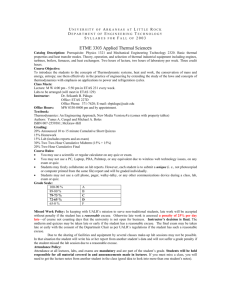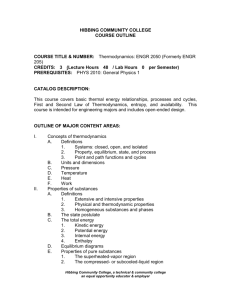College of Southern Maryland PHY-2310
advertisement
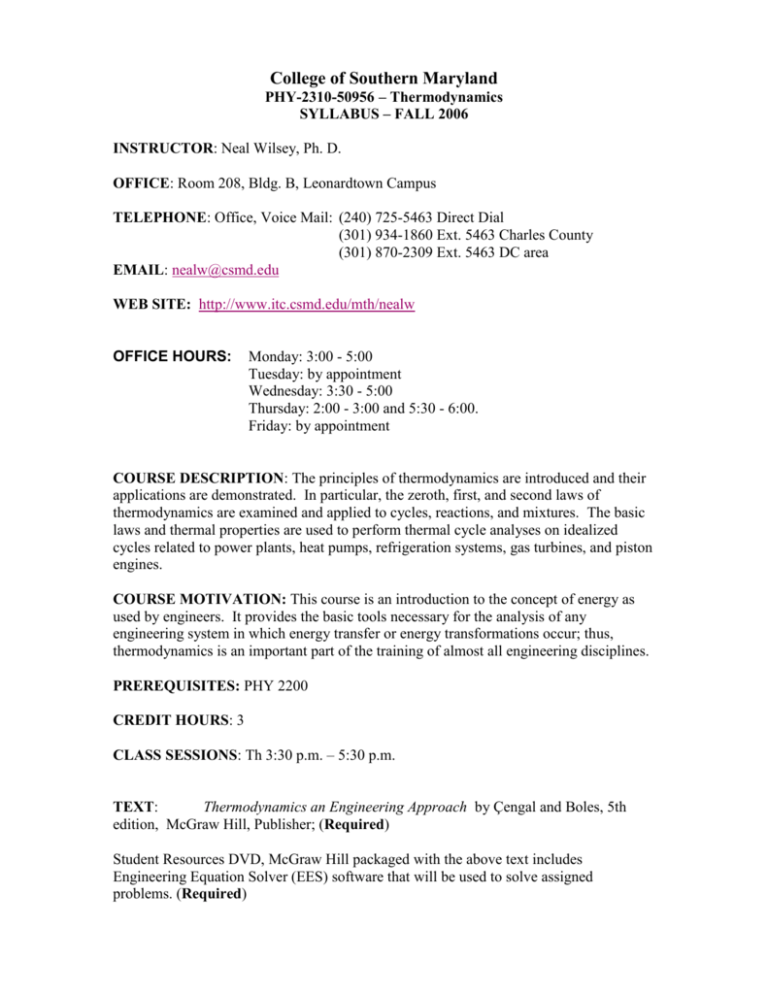
College of Southern Maryland PHY-2310-50956 – Thermodynamics SYLLABUS – FALL 2006 INSTRUCTOR: Neal Wilsey, Ph. D. OFFICE: Room 208, Bldg. B, Leonardtown Campus TELEPHONE: Office, Voice Mail: (240) 725-5463 Direct Dial (301) 934-1860 Ext. 5463 Charles County (301) 870-2309 Ext. 5463 DC area EMAIL: nealw@csmd.edu WEB SITE: http://www.itc.csmd.edu/mth/nealw OFFICE HOURS: Monday: 3:00 - 5:00 Tuesday: by appointment Wednesday: 3:30 - 5:00 Thursday: 2:00 - 3:00 and 5:30 - 6:00. Friday: by appointment COURSE DESCRIPTION: The principles of thermodynamics are introduced and their applications are demonstrated. In particular, the zeroth, first, and second laws of thermodynamics are examined and applied to cycles, reactions, and mixtures. The basic laws and thermal properties are used to perform thermal cycle analyses on idealized cycles related to power plants, heat pumps, refrigeration systems, gas turbines, and piston engines. COURSE MOTIVATION: This course is an introduction to the concept of energy as used by engineers. It provides the basic tools necessary for the analysis of any engineering system in which energy transfer or energy transformations occur; thus, thermodynamics is an important part of the training of almost all engineering disciplines. PREREQUISITES: PHY 2200 CREDIT HOURS: 3 CLASS SESSIONS: Th 3:30 p.m. – 5:30 p.m. TEXT: Thermodynamics an Engineering Approach by Çengal and Boles, 5th edition, McGraw Hill, Publisher; (Required) Student Resources DVD, McGraw Hill packaged with the above text includes Engineering Equation Solver (EES) software that will be used to solve assigned problems. (Required) Properties Table Booklet (ISBN 0-07-28897-5) (Required) If you purchased your text in the CSM Bookstore, the booklet was included in the package. CALCULATOR: Scientific Calculator (Required) A graphing calculator is recommended. WEB HYBRID: This section is a blended course. Most course information is delivered via WebCT. However, the class meets two hours each week to go over course materials and perform lab activities. Assignments, homework solutions, and quizzes will be given online and the student has available all of the WebCT features. Nearly all of the text publisher’s online offerings are also available via the WebCT site. Students are expected to log into the course web site daily to check for postings and calendar updates. WebCT can be accessed via “MyWebCT” from the CSM web site. COURSE OBJECTIVES: Students will be asked to demonstrate their knowledge of the material covered in this first thermodynamics course through their mastery of the following course objectives. Through the study of this material the student will be able to: 1. Determine properties of real substances, such as steam and refrigerant 134-a, and ideal gases from either tabular data or equations of state. Use absolute, gage, and vacuum pressures correctly. Calculate gage and vacuum pressures using the manometer equation. Use absolute and Celsius temperatures correctly. Determine property data using the steam and R-134a tables. Sketch P-v, T-v, and P-T plots for steam, R-134a, and ideal gases. Locate data states on P-v, T-v, and P-T plots for steam, R-134a, and ideal gases. Determine the condition of a data state as a compressed, saturated, or superheated state and determine the thermodynamic properties at that state by using property tables. Demonstrate the use of quality in finding properties of two-phase substances. Apply the concept of the generalized compressibility factor to demonstrate when the ideal gas equation may be used to determine the state of a gas. Apply the ideal gas equation to solve problems involving pressure, temperature, and volume of ideal gases. Determine changes in internal energy and enthalpy for ideal gases. Determine mass flow rate from its definition and relation to volume flow rate. 2. Analyze processes involving ideal gases and real substances as working fluids in both closed systems and open systems or control volumes to determine process diagrams, apply the first law of thermodynamics to perform energy balances, and determine heat and work transfers. Determine the pressure-volume relation for processes and plot the processes on Pv and diagrams. Calculate the boundary work for a variety of processes for closed systems. Apply the first law to closed systems containing ideal gases, steam, or R-134a to determine heat transfer, work, or property changes during processes. Apply the first law to steady-flow open systems containing ideal gases, steam, and refrigerant-134a to determine heat transfer, work, and property changes during processes. 3. Analyze closed systems and control volumes through the application of the second law. Determine the efficiency of heat engines and compare with the Carnot heat engine efficiency. Determine the coefficient of performance of refrigerators and heat pumps and compare with refrigerators and heat pumps operating on the reversed Carnot cycle. Determine entropy changes for both ideal gases and real substances. Determine the properties of a working fluid at the end of an isentropic process. Plot processes on both P-v and T-s diagrams. Apply both the first and second laws to determine heat transfer, work, and property changes during processes occurring in both closed and open systems. 4. Analyze thermodynamic power, heat pump, and refrigeration cycles; perform psychrometric analyses. Analyze ideal gas power cycles to perform energy balances, determine heat and work transfers, and calculate the cycle efficiency; Analyze steam power cycles to perform energy balances, determine heat and work transfers, and calculate the cycle efficiency; Analyze vapor compression refrigeration cycles to perform energy balances, determine heat and work transfers, and calculate the cycle coefficient of performance; Calculate properties of ideal gas mixtures; Determine the properties of dry air-water vapor mixtures, plot processes on a psychrometric chart, and analyze process involving dry air-water vapor mixtures to perform energy and mass balances for the processes; PERFORMANCE EVALUATION: Student performance will be measured as follows: 4 unit exams (see attached schedule): 15 % each, 60% total. Homework: 10% of the total Group Projects (Labs): 10 % of the total. 6 Quizzes, lowest score dropped – 4% each (20 % of total). Final grades will be assigned as follows: 90 – 100% A 80 – 89% B 70 – 79% C 60 – 69% D Below 60% F HOMEWORK: Homework assignments will be announced in class and published on the course web site. Selected homework problems will be graded. Students should be prepared to present homework problems at the following class session. GROUP PROJECTS: Several virtual laboratory group activities will be assigned. Students work together as a group to determine how the assignment can be completed by using the laboratory description and the data file provided. Each student is required to submit a lab report for grading. ATTENDANCE POLICY: Students are required to attend each class session. In case of sickness or other valid cause of absence, students should contact the instructor. Students auditing the class should also attend regularly to obtain the grade of "audit." Excessive absences generally lead to poor test performances and, therefore, low grades. Each student is responsible for all assignments, activities, and announcements made during any regularly scheduled class. AUDIT AND WITHDRAWAL POLICY: Students are reminded to consult the College Catalog for dates, procedures, responsibilities and impacts of changing registration status. November 16 (Thursday) is the last day to withdraw from a course or change from AUDIT status to CREDIT status or from CREDIT to AUDIT. Auditing students are required to sign an agreement with the instructor before November 16. Failure to keep the terms of the agreement will receive a grade of WD for the course. MAKEUP EXAM POLICY: Makeup exams will be allowed without penalty for legitimate reasons if the instructor is notified in advance or if an unavoidable emergency occurs. All makeup exams will be administered in the Testing Center and will be scheduled by the instructor. STUDENT INTEGRITY POLICY: Students are expected to perform independently on exams and quizzes without the use of unauthorized materials (notes, etc.). Any violations of the Student Code of Conduct as outlined in the Student Handbook result in a score of zero for the exam or quiz. The violation will be reported to the Director of Student Affairs and to the College Judicial Committee for review and possible disciplinary action. DISABILITIES AND SPECIAL NEEDS: Students with disabilities who believe that they may need accommodations in this class are encouraged to contact Disabled Student Services in the Learning Assistance Department at 301.934.7614 as soon as possible to better ensure that such accommodations are implemented in a timely fashion. UNAUTHORIZED PERSONS: Unauthorized persons (children, friends, family members, and any other persons not registered for the course) are not allowed in the classroom. Details of this college policy can be found in the Student Handbook. COURSE OUTLINE - PHY 2310 – Fall, 2006 Week Date Text Ref. Topics and Events 8 8/25 – 9/1 Lecture 8/31 1.1-1.3 1.4-1.7 1.8-1.9 1.10-1.13, 2.1 2.2-2.4 Introduction, Definitions, Units, Systems Properties, State Processes, Cycles State postulate, Temperature Pressure, Problem-Solving, Energy Heat Transfer, Work Introduction to the EES software. 2 9/2 – 9/8 Lecture 9/7 2.5 2.6 3.1-3.3 3.4 3.5 3.6 3.7-3.8 The First Law of Thermodynamics Energy Conversion Efficiencies Pure Substance, Phase-Change Property Diagrams Thermodynamic Property Tables The Ideal-Gas Equation of State Compressibility Factor, Other Equations of State 3 9/9 – 9/15 Lecture 9/14 1 Review Chapters 1 – 3, Problem Solving Test #1 – Chapters 1 – 3 9/16 – 9/22 Lecture 9/21 4.1 4.2 4.3 4.4 4.5 Moving Boundary Work Energy Balance for Closed Systems Specific Heats Internal Energy, Enthalpy, Specific Heats for Ideal Gases Internal Energy, Enthalpy, Specific Heats of Solids and Liquids 5 9/23 – 9/29 Lecture 9/28 5.1 5.2 5.3 5.4 5.4 5.4 5.4 5.4 5.5 6 9/30 – 10/6 Lecture 10/5 Mass Balance for Control Volumes Flow Work and the Energy of a Flowing Fluid Energy Balance for Steady-Flow Systems Some Steady-Flow Engineering Devices Nozzles, Diffusers Turbines, Compressors Throttling valves, Mixing chambers Heat exchangers, Pipe and Duct Flow Unsteady-flow process Review Chapters 4 – 5, Problem Solving Test #2 – Chapters 4 – 5 Introduction to the Second law, Thermal Reservoirs Heat engines Refrigerators, Heat Pumps, Perpetual-Motion Machines Reversible & Irreversible Processes, Carnot cycle Carnot Principles, The Thermodynamic Temperature Scale Carnot Heat Engine Carnot Refrigerator and Heat Pump 4 7 10/7 – 10/13 Lecture 10/12 6.1-6.2 6.3 6.4-6.5 6.6-6.7 6.8-6.9 6.10 6.11 8 10/14 – 10/20 Lecture 10/19 7.1 7.2 7.3-7.4 7.5-6.6 7.7-7.8 7.9 7.10-7.11 7.12 7.13 9 10/21 – 10/27 Lecture 10/26 Chs 6 & 7 Review of Chapters 6 and 7;Test 3 for Chapters 6 and 7 10/28 – 11/3 Lecture 11/2 9.1-9.4 9.5 9.6 9.7-9.8 9.11-9.12 Basic Considerations, Carnot cycle, Air standard cycle Otto Cycle Diesel Cycle Stirling, Ericsson, Brayton Cycles Ideal Jet-Propulsion Cycles, Second-Law Analysis 11 11/4 – 11/10 Lecture 11/9 10.1-10.3 10.4-10.5 10.6 10.7 Carnot and Rankine Vapor Cycles Parameters Affecting Efficiency, Reheat Cycle Regenerative Rankine Cycle Second-Law Analysis of Vapor Power Cycles 12 11/11 – 11/17 Lecture 11/16 13 11/18 – 11/21 Thanksgiving Break 11/22 – 11/26 No Lecture Chs 9 & 10 11.1-11.2 11.3 11.4 13.1 13.2 13.3 14 11/27 – 12/1 Lecture 11/30 14.1-14.3 14.4 14.5-14.7 Adiabatic Saturation and Wet-Bulb Temperatures Psychrometric Chart, Air Cond. Processes Gas Mixtures: Ideal Gases, Gases & Vapors, Psychrometrics 11, 13, 14 Review for Final Exam 11, 13, 14 Final Exam 10 15 16 12/2 – 12/8 Lecture 12/7 12/8 – 12/14 Test #4 12/14 Entropy The Increase of Entropy Principle Entropy Change of Pure Substance, Isentropic Processes Property Diagrams Involving Entropy, What Is Entropy Tds Relations, Entropy Change of Liquids and Solids Entropy change of Ideal Gases Reversible Steady-Flow Work, Compressor work Isentropic Efficiencies of Steady-Flow Devices Entropy Balance Review of Chapters 9 and 10;Test 3 for Chapters 9 and 10 Refrigerators & Heat Pumps, Reversed Carnot Cycle Ideal Refrigeration cycle Actual Vapor-Compression Refrigeration Cycle Composition of Gas Mixtures P-v-T Behavior of Gas Mixtures Properties of Gas Mixtures
